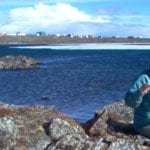In the summer of 1859, Captain Sherard Osborn of the British Royal Navy stood on Cameron Island, Nunavut, looking at his boots. He and crew had been sent there to determine the fate of HMS Erebus and HMS Terror, two ships that had been lost a decade earlier as part of the ill-fated Franklin expedition. As he kicked over some loose stones, he noticed a bone-shaped fragment that fit neatly into his palm. For whatever reason, he decided to pocket the specimen. Little did he know that the fossil’s true identity—much like the location of the ships that Osborn was searching for—would remain a mystery for another 150 years.
“I’m sure he just thought it was an interesting-looking rock,” says Hans Sues, Curator of Vertebrate Paleontology at the Smithsonian National Museum of Natural History. Sues is the author of a new paper in the Canadian Journal of Earth Sciences that aims to finally answer the question of where the creature that left Osborn’s fossil fits into the tree of life.
Sues explains that even though Royal Navy sailors were not necessarily well-versed in the sciences, they would often pick up items to be identified by experts back home. “Minerals, rocks, fossils, interesting biological specimens, you name it,” he says. “They really vacuumed the place!”
In a detailed account of the voyage published by Osborn’s boss, Captain Francis McClintock, the fossil bone was recorded as belonging to an ichthyosaur, an ocean-dwelling reptile somewhat similar in appearance to modern-day dolphins. Sues says that’s wrong, but understandable. “In the south of England, there are a lot of ichthyosaur fossils, so lots of people from the British Isles were familiar with them,” he says. “It makes sense that they would jump to that conclusion, but it looks completely different from that.”
The first scientific description of the fossil didn’t appear until 1875, the same year Osborn died. Its author, the Scottish physician and naturalist Andrew Leith Adams, identified it as a cervical vertebra, a bone found in the neck. However, while confirming its reptilian origin, Adams wasn’t confident enough to say what kind of reptile it was, calling it simply “saurian”. The name he proposed, Arctosaurus osborni, translates roughly as “Arctic-dwelling reptile found by Captain Osborn.”




